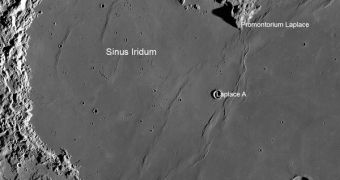The Chinese National Space Administration's (CNSA) first lunar lander, was able to reach its injection orbit around the Moon on Friday, December 6, less than five days after launching into space from the Xichang Satellite Launch Center, in Sichuan Province, China.
The spacecraft contains a lander and a small, six-wheeled rover. Both robotic explorers were built by the Shanghai Aerospace System Engineering Institute, and weigh a combined 1,200 kilograms (2,600 pounds).
The mission consists of the Chang'e-3 lunar lander, named after the traditional Chinese lunar deity, and the Yutu rover, which is named after her pet. The latter weighs just over 120 kilograms (260 pounds). The mission launched aboard a Long March 3B delivery system, on December 1, 2013.
Now that the spacecraft is in orbit around the Moon, CNSA experts can begin preparations for landing, which is scheduled to occur on December 14, at a site called Sinus Iridium, or the Bay of Rainbows. This location is the remnant of a large impact crater, which was flooded with basaltic lava long ago.
Chang'e-3 is the third mission in China's ambitious program to explore the Moon, and represents an extension of the Chang'e-1 and Chang'e-2 lunar orbiters, launched in 2007 and 2010, respectively.
According to the state-run Xinhua news agency, the spacecraft was able to achieve orbital insertion around the Moon at 0953 GMT on Friday, and is now cruising at an altitude of about 100 kilometers (60 miles) above the lunar surface.
Later in the week, Chang'e-3 will reduce its altitude even further. Once it is in position, its variable-thrust main engine will fire for several minutes before the spacecraft makes a soft landing in the Bay of Rainbows, the first spacecraft in nearly four decades to land in this manner on Earth's natural satellite.
Officials with the European Space Agency (ESA), which is providing telemetry and data relay support to CNSA for this mission, say that the Yutu rover will drive off the lander a few hours after touchdown this Saturday. The robot features nuclear heaters that allegedly contain plutonium-238.
Chang'e-3 will provide CNSA with more knowledge and know-how for future missions of the Moon. The Asian nation has a very ambitious program for exploring space, both in Earth's orbit and on the Moon. Its space agency is already planning to build a space station, and to land astronauts on the Moon, Space reports.

 14 DAY TRIAL //
14 DAY TRIAL //